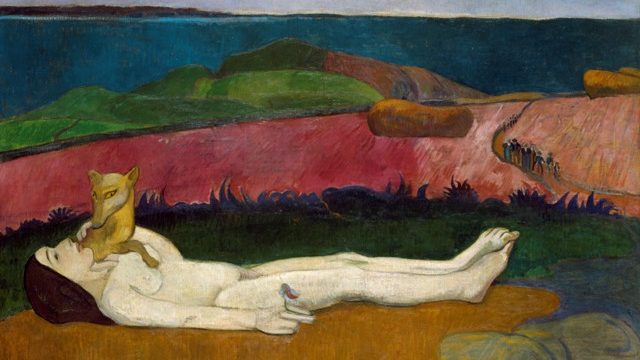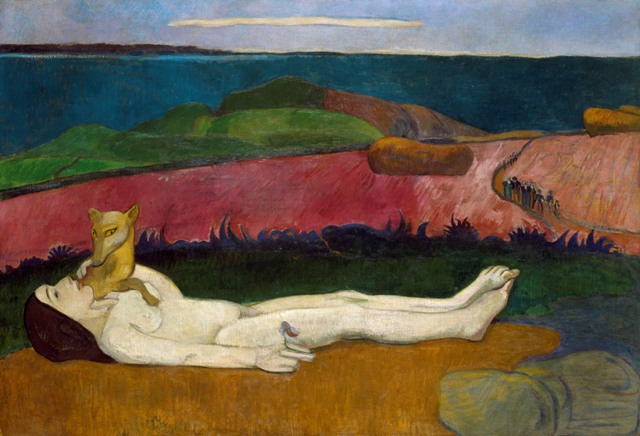
Paul Gauguin
(French, 1848–1903)
The Loss of Virginity, 1890–91
Oil on canvas
Gift of Walter P. Chrysler, Jr.
By Betsy DiJulio
In January, Lloyd DeWitt, Ph.D., was named chief curator of European Art at the Chrysler Museum of Art. Hailing from a post as curator of European Art at the Gallery of Ontario, Toronto’s leading art museum, DeWitt is recognized as a 17th century Dutch art specialist, a broad based scholar, and a skilled non-profit manager.
Chosen during an extensive international search, DeWitt brings to the Chrysler a proven record of organizing important exhibitions, with all of the scholarly rigor and artistic acumen that entails.
According to its leadership, the Chrysler stands poised to make an even bigger imprint on the national and international stages with DeWitt, who holds a PhD in art history from University of Maryland, helping to lead the charge. Widely published and decorated, he is also a sought-after speaker.
We recently caught up with DeWitt between deadlines and travel to answer a few questions, including his Canadian perspective on local food and music. Here’s a taste of the man chosen to lead a team of seven curators, conservators, fellows, researchers and administrative staff.
Lloyd, in the current political climate, there has been a lot of joking about Americans moving to Canada, but you crossed over the other way. What do you think of your new home in Norfolk as compared to Toronto?
Two words: Rob Ford. But seriously, we’re having a lot of fun here, especially in discovering all the things that set the Hampton Roads area apart. The museum and the area are both wonderful, full of history and interest, and word is getting out.
It seems like the term “curate” is tossed around a lot these days, especially in regard to upscale items for the home and the like, e.g. “a curated collection of dinnerware.” Will you explain what “to curate” means in your position as Chief Curator at The Chrysler?
It’s flattering to us that so many things get curated, even children’s birthday parties. At heart, we still “take care” of the collections but these days pay a lot of attention to making the Chrysler a great experience for all our visitors.
Now that you’ve been at your current post for a few months, would you be willing to share your vision with VEER readers?
The Chrysler is a leader in broadening access to our visitors and welcoming to our great collection and programs, a vision I share and feel strongly about. A big part of that is getting people to tell us what’s important to them about art and their experiences here.
You have mentioned that you hope to achieve a higher global profile for The Chrysler. Do you mind sharing how you plan to go about that?
Partnerships with exceptional national and international institutions are a key way to do this.
Curators wear a lot of hats. How do you balance the various aspects of your job from organizing major exhibitions to scholarly research and writing? And what do you see as the connection between the two?
Research and exhibitions are co-dependent; our current and future exhibition and installation projects drive research. This fits into a larger framework of prioritizing according to larger strategic objectives, so we’re frequently adjusting and realigning what we’re working on.
Asking a curator to select a favorite object from a collection is like asking a parent to choose a favorite child. But do you have a secret on any one object or two in The Chrysler collections?
It changes week to week, depends on what I’m working on. I’m really into Rashid Johnson’s Black Hole, a new acquisition. I’m also looking into a wonderful and very fine, very wonky group portrait called Last Supper with Donors, Netherlandish c. 1575, which seems to have a great social and religious story behind it.
I read that you serve on the board of the Historians of Netherlandish Art. Northern Renaissance art was an area of emphasis for me in my graduate program in art history. What are a couple of the most prized Netherlandish pieces in The Chrysler’s collection?
The Jan Gossaert Virgin and Child is my favorite from that period, although the Early Netherlandish portraits are also unusually good. The Master of the Virgo inter Virgines Crucifixion is another one I especially love, both moving and quirky.
The July issue was the “food and beverage” issue of VEER and I’m wondering if you would humor us by asking these two food-related question: 1) What items are in your refrigerator right now? 2) We don’t have poutine here, but are there any local specialties you have tried that just may become favorites?
1) We’re down to our last quart of the maple syrup we cooked from our own tree, incomparable stuff. Other than that we haven’t replenished the fridge from vacation. 2) We’re working our way through Handsome Biscuit’s menu. The Hella Fitzgerald could give any poutine a run for its money. Wisteria’s ham biscuits and desserts are a weak spot. Coelacanth’s Trick Pony is another local favorite.





